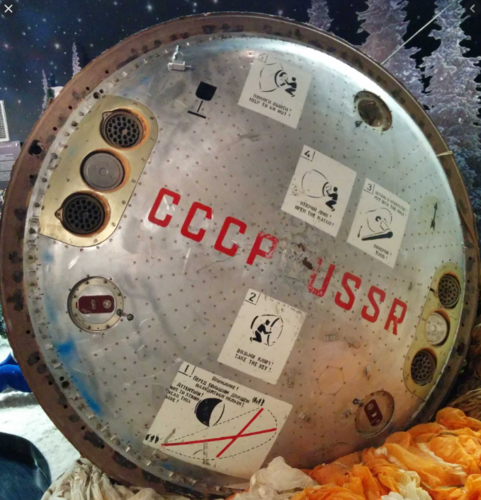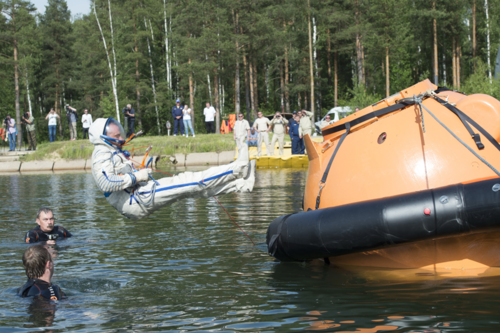You are using an out of date browser. It may not display this or other websites correctly.
You should upgrade or use an alternative browser.
You should upgrade or use an alternative browser.
Why The USSR Had Plans To Land Spacecraft in The USA During Emergencies
- Thread starter Flyaway
- Start date
chimeric oncogene
ACCESS: Secret
- Joined
- 23 May 2019
- Messages
- 312
- Reaction score
- 321
What's the alternative for emergency landings in the Western Hemisphere? Canada?
The Amazon? Patagonia? Mexico? None of those sound as appealing as landing in the US of A to a peacetime cosmonaut.
The Amazon? Patagonia? Mexico? None of those sound as appealing as landing in the US of A to a peacetime cosmonaut.
- Joined
- 13 August 2007
- Messages
- 7,881
- Reaction score
- 9,009
emergency landing in USA is preferred, compare to like Amazonian Jungle or Africa desert
But not USA during the Cold war...
another option would be landing in Australia
in fact NASA look into that for ISS in 1992
But not USA during the Cold war...
another option would be landing in Australia
in fact NASA look into that for ISS in 1992
emergency landing in USA is preferred, compare to like Amazonian Jungle or Africa desert
But not USA during the Cold war...
I disagree. Even during the Space Race, there was communication between the two (e.g. when the Luna 15 and Apollo 11 missions were run simultaneously). During Apollo 13, the Russians offered all kinds of help e.g. for recovery.
I find it unlikely the US wouldn't respond in kind if a Soyuz crew had run into trouble.
archipeppe
ACCESS: Top Secret
- Joined
- 18 October 2007
- Messages
- 2,376
- Reaction score
- 2,784
I agree with Hobbes, even during the Cold War Russians envisioned the possibility to land the Soyuz SA module within U.S. territories, the proof is the label written in Russian/English languages on the back side of the spacecraft.
You may see them on this Soyuz TM-7 SA module exposed in a Museum, the TM-7 returned to Earth in 1989 during the Cold War.

You may see them on this Soyuz TM-7 SA module exposed in a Museum, the TM-7 returned to Earth in 1989 during the Cold War.

Last edited:
- Joined
- 29 July 2009
- Messages
- 1,633
- Reaction score
- 1,958
According to the Outer Space Treaty of 1967, which the US and USSR agreed upon, was that "principle of cooperation and mutual assistance" be maintained concerning the rendering of aid to astronauts/cosmonauts in need. That would of course include the recovery of a wayward capsule.
Dilandu
I'm dissatisfied, which means, I exist.
Because USA is the only landmass big enough along the most trajectories on which Soviet spacecrafts were launched. Soviet capsules weren't designed for water landing; in case of emergency, landing on American continent was preferable.
archipeppe
ACCESS: Top Secret
- Joined
- 18 October 2007
- Messages
- 2,376
- Reaction score
- 2,784
Soviet capsules weren't designed for water landing;
Sorry but this is absolutely not true.
Since Vostok Russian manned Spacecrafts were designed for water landing, even if the nominal case was ground landing.
The proof is that cosmonauts have always received water training, while especially Soyuz proved to be water resistant during the Zond missions, when most of Zond's reentry modules (essentially a lunar Version of Soyuz) were successfully recovered into the Indian Ocean.
And there was a Soyuz (mission 23, 1976, to an almaz station) that landed, among 4000 miles of continuous steppe dry flatlands, straight into lake Tengiz. Which was frozen, but then the ice broke under the weight of a superheated, 11 000 pound Soyuz. And thus the silly thing ended at the bottom of the lake.
Imagine the quandary for the soviets: how to we get the freakkin' thing (and the obviously drawned cosmonauts inside) out of the lake ?
They tried everything, and finally dragged the Soyuz to the shore with an helicopter. They opened the hatch, bracing themselves for another Soyuz 11 tragedy... and found the crew alive inside. They had saved power, and waited for a death that never come. Meanwhile the capsule remained water-tight. Unbelievable.
Soyuz rocks, really.
Also Soyuz 5 that re-entered head-on (not ass-on, where the heatshield is) because of a stupid module and a stupid non-explosive bolt, nearly incinerating cosmonaut Volynov. Before shredding the module right in the middle of an inverted, whacky, hellish reentry... and then, right in the middle of Hell, the capsule made the mandatory 180 degree turn and got the heatshield in the correct position... and Volynov was saved.
Plus Soyuz 18 and Soyuz T-10-1 that proved their own way how useful is an escape tower. Also the more recent mishap.
Imagine the quandary for the soviets: how to we get the freakkin' thing (and the obviously drawned cosmonauts inside) out of the lake ?
They tried everything, and finally dragged the Soyuz to the shore with an helicopter. They opened the hatch, bracing themselves for another Soyuz 11 tragedy... and found the crew alive inside. They had saved power, and waited for a death that never come. Meanwhile the capsule remained water-tight. Unbelievable.
Soyuz rocks, really.
Also Soyuz 5 that re-entered head-on (not ass-on, where the heatshield is) because of a stupid module and a stupid non-explosive bolt, nearly incinerating cosmonaut Volynov. Before shredding the module right in the middle of an inverted, whacky, hellish reentry... and then, right in the middle of Hell, the capsule made the mandatory 180 degree turn and got the heatshield in the correct position... and Volynov was saved.
Plus Soyuz 18 and Soyuz T-10-1 that proved their own way how useful is an escape tower. Also the more recent mishap.
Last edited:
archipeppe
ACCESS: Top Secret
- Joined
- 18 October 2007
- Messages
- 2,376
- Reaction score
- 2,784
Dilandu
I'm dissatisfied, which means, I exist.
Sorry but this is absolutely not true.
Since Vostok Russian manned Spacecrafts were designed for water landing, even if the nominal case was ground landing.
The proof is that cosmonauts have always received water training, while especially Soyuz proved to be water resistant during the Zond missions, when most of Zond's reentry modules (essentially a lunar Version of Soyuz) were successfully recovered into the Indian Ocean.
Must admit, my phrase wasn't correct. What I means, is that water landing wasn't the standard situation for our capsules, and land landing was generally considered preferable.
archipeppe
ACCESS: Top Secret
- Joined
- 18 October 2007
- Messages
- 2,376
- Reaction score
- 2,784
Sorry even if Italian I'm a huge fan of Russian space technology, especially Korolev 's brainchilds. Often there are a lot of incorrect infos about such topic.Sorry but this is absolutely not true.
Since Vostok Russian manned Spacecrafts were designed for water landing, even if the nominal case was ground landing.
The proof is that cosmonauts have always received water training, while especially Soyuz proved to be water resistant during the Zond missions, when most of Zond's reentry modules (essentially a lunar Version of Soyuz) were successfully recovered into the Indian Ocean.
Must admit, my phrase wasn't correct. What I means, is that water landing wasn't the standard situation for our capsules, and land landing was generally considered preferable.
- Joined
- 9 October 2009
- Messages
- 21,147
- Reaction score
- 12,249
IIRC, the early Vostoks weren't rated for water landings.
- Joined
- 29 July 2009
- Messages
- 1,633
- Reaction score
- 1,958
I believe all Cosmonauts ejected from the Vostok, due to excessive G's on impact under the capsule's parachute recovery system. Developing a water recovery system for the capsule may have been considered unnecessary as flights were planned to be recovered on land. If a Vostok landed in the water, the hatch would have already been deployed (to facilitate Cosmonaut ejection) and the capsule most likely would have sunk, unless a relatively large floatation system was installed. When the Vostok was designed, considering that it was in an era to get a man in to space soonest, such a floatation system may have been considered over-engineering. It would be interesting to see if the USSR ever tested the Vostok in the water to look at such a system. The NAZ ejection seat was tested in the water and it was deemed unseaworthy (http://www.astronautix.com/v/vostok1.html).
Link below shows ejection seat tests and water a little water survival training.
Link below shows ejection seat tests and water a little water survival training.
Getty Images
Getty Images. Find high resolution royalty-free images, editorial stock photos, vector art, video footage clips and stock music licensing at the richest image search photo library online.
www.gettyimages.com
Last edited:
including the North American Prairies
If we examine the North American recovery points in the map below we see that there are landing oints in Manitoba, Saskatchewan, North Dakota, Texas and, Oklahoma. The Texas landing point for Soyuz-33 at 33N, 97.6 W is actually quite close to Fort Worth (32.75 N, 97.32 W )where Mark Severance recorded the landing angle data!
Imagine the cultural shock... for the Soviets... and for the Texans !
Similar threads
-
NASA’s Abandoned Plan To Carry Soviet Spacecraft in the Space Shuttle
- Started by Flyaway
- Replies: 4
-
-
-
Grumman Horizontal Landing Logistics Spacecraft proposals
- Started by Triton
- Replies: 7
-

